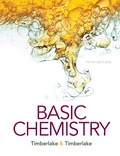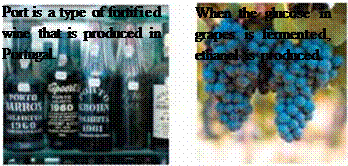
EBK BASIC CHEMISTRY
5th Edition
ISBN: 8220101472335
Author: Timberlake
Publisher: PEARSON
expand_more
expand_more
format_list_bulleted
Concept explainers
Textbook Question
Chapter 14, Problem 24CI
In wine-making, glucose



- Calculate the volume percent (v/v) of ethanol in the port wine.
- What is the molarity (M) of ethanol in the port wine?
- Write the balanced chemical equation for the fermentation reaction of sugar in grapes.
- How many grams of sugar from grapes are required to produce one bottle of port wine?
- How many bottles of port wine can be produced from 1.0 ton of grapes (1 ton = 2000 lb) ?
Expert Solution & Answer
Want to see the full answer?
Check out a sample textbook solution
Students have asked these similar questions
9.116 Lithium chloride has a solubility of 55 g of LiCl in 100. g of
H,O at 25 °C. Determine if each of the following mixtures
forms an unsaturated or saturated solution at 25 °C: (9.3)
a. adding 10 g of LiCl to 15 g of H;O
b. adding 25 g of LİCI to 50. g of H,0
c. adding 75 g of LiCl to 150. g of H,O
ne
on
ne
You have a large bottle of 10.0 M hydrochloric acid and you want to make 6.0 L of 3.0 M hydrochloric acid. How much concentrated do you need and how much water? (1.8, 4.2)
One of the reactions in the industrial production ofnitric acid involves the production of nitric oxide:
4 NH3(g) 1 5 O2(g) → 4 NO(g) 1 6 H2O(g) (7.4) T/I
a) If 4500 kg of ammonia, NH3(g), react with7500 kg of O2, what mass of NO will form?
(b) What mass of the excess reagent will remain?
Chapter 14 Solutions
EBK BASIC CHEMISTRY
Ch. 14.1 - Indicate whether each of the following statements...Ch. 14.1 - Prob. 14.2QAPCh. 14.1 - Prob. 14.3QAPCh. 14.1 - Name each of the following acids or bases: a....Ch. 14.1 - Write formulas for each of the following acids and...Ch. 14.1 - Write formulas for each of the following acids and...Ch. 14.2 - Identify the reactant that is a Bronsted-Lowry...Ch. 14.2 - Prob. 14.8QAPCh. 14.2 - Prob. 14.9QAPCh. 14.2 - Prob. 14.10QAP
Ch. 14.2 - Prob. 14.11QAPCh. 14.2 - Prob. 14.12QAPCh. 14.2 - Identify the Bronsted-Lowry acid-base pairs in...Ch. 14.2 - Prob. 14.14QAPCh. 14.2 - Prob. 14.15QAPCh. 14.2 - Prob. 14.16QAPCh. 14.3 - What is meant by the phrase ”A strong acid as a...Ch. 14.3 - Prob. 14.18QAPCh. 14.3 - Prob. 14.19QAPCh. 14.3 - Prob. 14.20QAPCh. 14.3 - Prob. 14.21QAPCh. 14.3 - Prob. 14.22QAPCh. 14.3 - Prob. 14.23QAPCh. 14.3 - Prob. 14.24QAPCh. 14.3 - Prob. 14.25QAPCh. 14.3 - Prob. 14.26QAPCh. 14.4 - Answer true or false for each of the following: A...Ch. 14.4 - Prob. 14.28QAPCh. 14.4 - Prob. 14.29QAPCh. 14.4 - Consider the following acids and their...Ch. 14.4 - Prob. 14.31QAPCh. 14.4 - Prob. 14.32QAPCh. 14.5 - Why are the concentrations of H3O+ and OH- equal...Ch. 14.5 - Prob. 14.34QAPCh. 14.5 - Prob. 14.35QAPCh. 14.5 - Prob. 14.36QAPCh. 14.5 - Prob. 14.37QAPCh. 14.5 - Prob. 14.38QAPCh. 14.5 - Prob. 14.39QAPCh. 14.5 - Prob. 14.40QAPCh. 14.5 - 11.41 Calculate the of each aqueous solution with...Ch. 14.5 - Prob. 14.42QAPCh. 14.6 - Prob. 14.43QAPCh. 14.6 - Prob. 14.44QAPCh. 14.6 - State whether each of the following solutions is...Ch. 14.6 - State whether each of the following solutions is...Ch. 14.6 - Prob. 14.47QAPCh. 14.6 - Prob. 14.48QAPCh. 14.6 - Prob. 14.49QAPCh. 14.6 - Prob. 14.50QAPCh. 14.6 - Prob. 14.51QAPCh. 14.6 - Prob. 14.52QAPCh. 14.6 - Prob. 14.53QAPCh. 14.6 - Prob. 14.54QAPCh. 14.7 - Prob. 14.55QAPCh. 14.7 - Complete and balance the equation for each of the...Ch. 14.7 - Prob. 14.57QAPCh. 14.7 - Prob. 14.58QAPCh. 14.7 - Prob. 14.59QAPCh. 14.7 - Prob. 14.60QAPCh. 14.8 - Prob. 14.61QAPCh. 14.8 - Prob. 14.62QAPCh. 14.8 - Prob. 14.63QAPCh. 14.8 - Prob. 14.64QAPCh. 14.8 - Prob. 14.65QAPCh. 14.8 - Prob. 14.66QAPCh. 14.8 - A solution of 0.204 M NaOH is used to titrate 50.0...Ch. 14.8 - Prob. 14.68QAPCh. 14.9 - Which of the following represents a buffer system?...Ch. 14.9 - Prob. 14.70QAPCh. 14.9 - Prob. 14.71QAPCh. 14.9 - Prob. 14.72QAPCh. 14.9 - Prob. 14.73QAPCh. 14.9 - Prob. 14.74QAPCh. 14.9 - Prob. 14.75QAPCh. 14.9 - Prob. 14.76QAPCh. 14.9 - Why would the pH of your blood plasma increase if...Ch. 14.9 - Why would the pH of your blood plasma decrease if...Ch. 14.9 - Prob. 14.79QAPCh. 14.9 - Someone with severe diabetes obtains energy by the...Ch. 14 - Prob. 14.81FUCh. 14 - When food enters the stomach, HCl is released and...Ch. 14 - Prob. 14.83FUCh. 14 - Prob. 14.84FUCh. 14 - Prob. 14.85FUCh. 14 - Prob. 14.86FUCh. 14 - Prob. 14.87FUCh. 14 - Prob. 14.88FUCh. 14 - Prob. 14.89UTCCh. 14 - Prob. 14.90UTCCh. 14 - Prob. 14.91UTCCh. 14 - Prob. 14.92UTCCh. 14 - Prob. 14.93UTCCh. 14 - Prob. 14.94UTCCh. 14 - Prob. 14.95UTCCh. 14 - Prob. 14.96UTCCh. 14 - Prob. 14.97UTCCh. 14 - Prob. 14.98UTCCh. 14 - Identify each of the following as an acid, base,...Ch. 14 - Idenúfy each of the following as an acid, base, or...Ch. 14 - Complete the following table: (11.2) Acid...Ch. 14 - Complete the following table: (11.2) Base...Ch. 14 - Using Table 11.3, identify the stronger acid in...Ch. 14 - Prob. 14.104AQAPCh. 14 - Determine the pH for each of the following...Ch. 14 - Determine the pH for each of the following...Ch. 14 - Prob. 14.107AQAPCh. 14 - Prob. 14.108AQAPCh. 14 - Calculate the [H3O+] and [OH] for a solution with...Ch. 14 - Calculate the [H3O+]and [OH]for a solution with...Ch. 14 - Solution A has a pH of 4.5, and solution B has a...Ch. 14 - Solution X has a pH of 9.5, and solution Y has a...Ch. 14 - What is the pH of a solution prepared by...Ch. 14 - Prob. 14.114AQAPCh. 14 - For each of the following: (11.2, 11.3) 1. H2S a....Ch. 14 - Prob. 14.116CQCh. 14 - Prob. 14.117CQCh. 14 - Prob. 14.118CQCh. 14 - Prob. 14.119CQCh. 14 - Prob. 14.120CQCh. 14 - Prob. 14.121CQCh. 14 - Prob. 14.122CQCh. 14 - Prob. 14.123CQCh. 14 - Prob. 14.124CQCh. 14 - Prob. 14.125CQCh. 14 - Prob. 14.126CQCh. 14 - Prob. 14.127CQCh. 14 - Prob. 14.128CQCh. 14 - Prob. 14.129CQCh. 14 - Prob. 14.130CQCh. 14 - Prob. 21CICh. 14 - Prob. 22CICh. 14 - Prob. 23CICh. 14 - In wine-making, glucose C6H12O6 from grapes...Ch. 14 - Prob. 25CICh. 14 - Prob. 26CICh. 14 - Prob. 27CICh. 14 - In a teaspoon (5.0 mL) of a liquid antacid, there...Ch. 14 - Prob. 29CICh. 14 - Prob. 30CICh. 14 - A volume of 200.0 mL of a carbonic acid buffer for...Ch. 14 - In the kidneys, the ammonia buffer system buffers...
Knowledge Booster
Learn more about
Need a deep-dive on the concept behind this application? Look no further. Learn more about this topic, chemistry and related others by exploring similar questions and additional content below.Similar questions
- should react most rapidly with Cl2 and AICI. (9.28.h) should have the highest boiling point, 7. Of the compounds shown below, B A. D. 8. Of the compounds shown below, NO2 HO, is not aromatic. (9.1 lg,i) 9. Of the compounds shown below, only - D Z-I Uarrow_forward(LO 7.1.1, 7.1.2, 7.2.1, 7.2.2) A small home might use about 6.50 moles of methane, CH4, per day in moderately cold weather for heating. How many moles of water will be produced when combusting 6.50 moles of methane? CH4 + CO₂ + 2.17 3.25 4.33 6.5 9.75 13.0 19.5 0₂ → 111- H₂O (unbalanced)arrow_forward(5.8)Which of the following reactions will form a gaseous product? O H₂CO3(aq) + Pb(NO3)2(aq) O NaOH(aq) + HNO3(aq) O None of these O Na₂SO3(aq) + H₂SO4(aq) ◄ Previousarrow_forward
- When 1.0 g of gasoline burns, it releases 11 kcal. The density of gasoline is 0.74 g/mL. (3.4, 3.6) How many megajoules are released when 1.0 gal of gasoline burns? If a television requires 150 kJ/h to run, how many hours can the television run on the energy provided by 1.0 gal of gasoline?arrow_forward1. (10.3- 1.24)/18.43 2. A penny minted after 1982 has a mass of 2.5 g Calculate total mass of three such pennies. 3. The following are placed in a beaker weighing 39.457 g: 2.689 g of NaCl, 1.26 g of sand and 5.0 g water. What is the final mass of the beaker? 4. If the beaker containing a sample of alcohol weighs 49.8767 g and the empty beaker weighs 49.214 g, what is the weight of the alcohol? 5. A flask that weighs 345.8 g is filled with 225 mL of carbon tetrachloride. The weight of the flask and carbon tetrachloride is found to be 703.55 g. From this information, calculate the density of carbon tetrachloride.arrow_forwardThis is possible because of the following reactions that take place rapidly as long as reactants are available: (11.3) Equation : 51-(aq) + IO-3(aq) + 6H+(aq) ----> 3I2(aq) +3H2O(I)arrow_forward
- (2 pts) Estradiol is a potent female hormone. In 1934, Edward A. Doisy of Washington University extracted 3000 lb of hog ovaries to isolate a few milligrams of pure estradiol. Doisy burned 5.00 mg of this precious sample in oxygen and found that 14.54 mg of CO2 and 3.97 mg of H20 were generated. 3. (a) Determine the empirical formula of estradiol. (b) The molecular weight of estradiol was later determined to be 272. Determine the molecular formula of estradiol.arrow_forwardshould react most rapidly with Clz and AICI. (9.28 h) 8. Of the compounds shown below, NO2 HO. D. 9. Qarrow_forward10.105 Complete and balance each of the following: (10.7) a. ZnCO3(s) + H,SO,(aq) b. Al(s) + HBr(aq)arrow_forward
- (6.3)The volume of a gas is 0.953 L at 30.0 °C. If the gas is heated to 60.0 °C, what would be the volume of the gas (in L) at this temperature? O 1.05 L O 0.867 L O 1.91 L O 0.477 Larrow_forwardHonors Chemistry-4th Hour- Dr. Paul / Gases / Lesson 148 11. Which state of matter is most accurately described by the kinetic molecular theory? O gas aqueous solid O liquid available! (3.0.227)arrow_forward(5.5, 5.7 & 5.8) Classify the following reaction. Ba(NO3)2(aq) + K₂SO4(aq) --> O acid-base reaction O gas-forming reaction O decomposition reaction O precipitation reactionarrow_forward
arrow_back_ios
SEE MORE QUESTIONS
arrow_forward_ios
Recommended textbooks for you
 Principles of Modern ChemistryChemistryISBN:9781305079113Author:David W. Oxtoby, H. Pat Gillis, Laurie J. ButlerPublisher:Cengage Learning
Principles of Modern ChemistryChemistryISBN:9781305079113Author:David W. Oxtoby, H. Pat Gillis, Laurie J. ButlerPublisher:Cengage Learning

Principles of Modern Chemistry
Chemistry
ISBN:9781305079113
Author:David W. Oxtoby, H. Pat Gillis, Laurie J. Butler
Publisher:Cengage Learning
Precipitation Reactions: Crash Course Chemistry #9; Author: Crash Course;https://www.youtube.com/watch?v=IIu16dy3ThI;License: Standard YouTube License, CC-BY